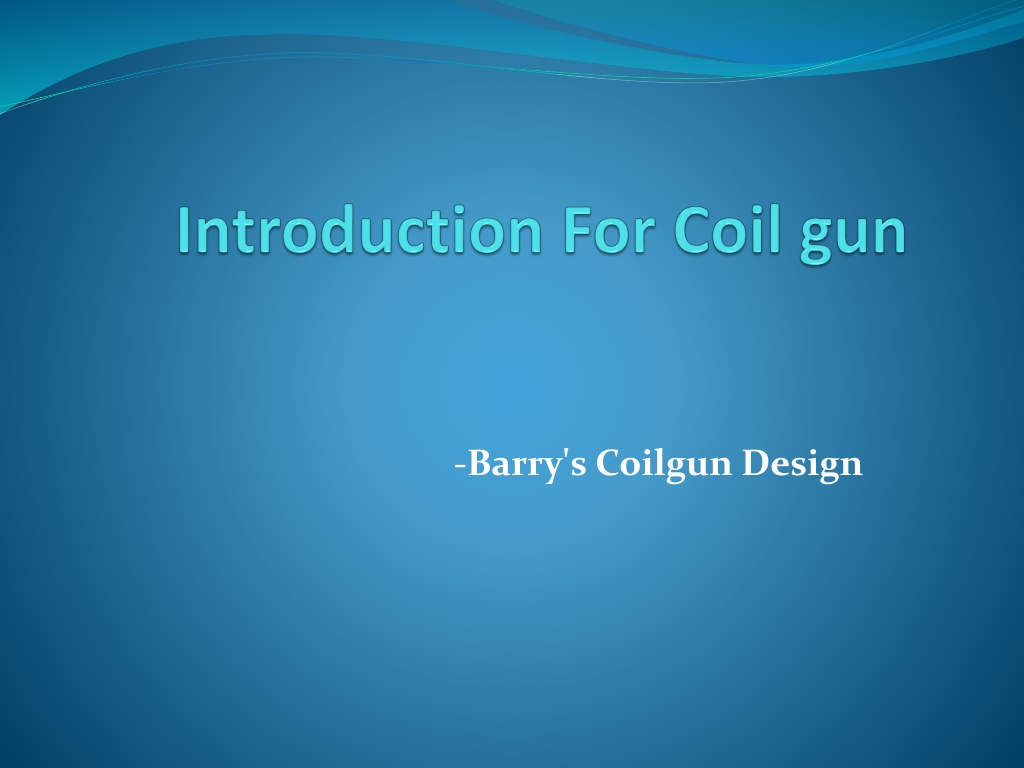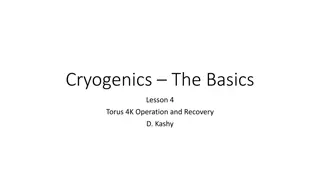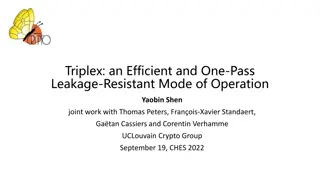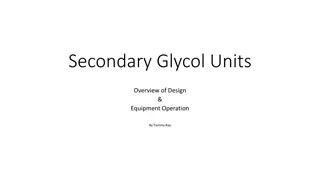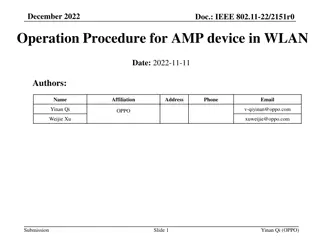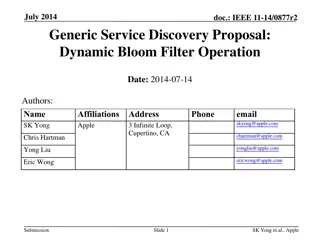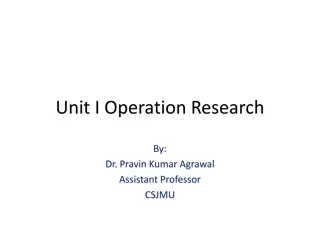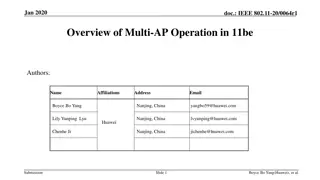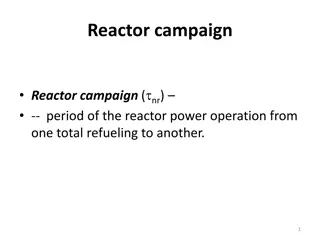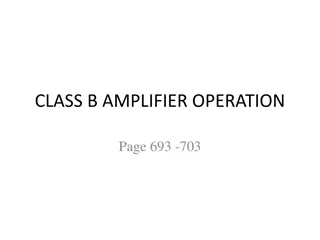Understanding Coilguns: A Comprehensive Overview of Coilgun Design and Operation
Coilguns, also known as Gauss guns, accelerate pieces of iron or steel using electromagnetic coils, creating a powerful magnetic field. This overview covers the principles behind coilguns, including magnetic materials, solenoid physics, energy storage in capacitors, and the role of inductors in damped oscillators. Learn about capacitor charge and discharge, inductance, and critical damping in coilgun design. Explore the fascinating world of coilguns and their applications in this detailed guide.
Download Presentation

Please find below an Image/Link to download the presentation.
The content on the website is provided AS IS for your information and personal use only. It may not be sold, licensed, or shared on other websites without obtaining consent from the author. Download presentation by click this link. If you encounter any issues during the download, it is possible that the publisher has removed the file from their server.
E N D
Presentation Transcript
What is a coilgun or gauss gun? It accelerates a piece of iron or steel down a tube. The tube runs through a series of electromagnetic coils (like solenoids). http://www.coilgun.info/about/home.htm Barry's Coilgun Design http://www.coilgun.info/about/home.htm
Introduction Magnetic Materials Solenoid Physics Magnetic Field Force From Magnetism Force Is the Gradient of Potential Energy The potential energy in a magnetic field is Saturation The B-H curve here illustrates the effect of magnetic saturation. It shows the effect of applying an external magnetic field to unmagnetized iron. http://www.coilgun.info/about/home.htm Barry's Coilgun Design http://www.coilgun.info/about/home.htm
Introduction Capacitors Energy Storage The charge or quantity of electricity that can be held in the electric field between the capacitor plates is proportional to the applied voltage and to the capacitance of the capacitor: Q = C * V where Q = charge in coloumbs C = capacitance in farads V = voltage in volts The energy stored in a capacitor is also a function of voltage and capacitance: W = V2* C / 2 where W = energy in joules (watt-seconds) V = voltage in volts C = capacitance in farads http://www.coilgun.info/about/home.htm Barry's Coilgun Design http://www.coilgun.info/about/home.htm
Capacitor Charge and Discharge q I I0=V0/R c I0= /R 0.63c =RC 0.37I0 t t Capacitor Charge q-t plot Capacitor Charge I-t plot I q t c 0.37I0 I0= /R 0.37c t Capacitor Discharge q-t plot Capacitor Discharge I-t plot National taiwan normal university http://www.coilgun.info/about/home.htm Barry's Coilgun Design http://www.coilgun.info/about/home.htm
Introduction Inductors (Coilgun) The symbol and defining equation for an inductor is ,where L is called the inductance. Damped Oscillator (RLC) The voltage V and current I as a function of time http://www.coilgun.info/about/home.htm Barry's Coilgun Design http://www.coilgun.info/about/home.htm
Introduction Critical Damping When R2C2-4LC is positive, then and are real numbers and the oscillator is over-damped. The circuit does not show oscillation. When R2C2-4LC is negative, then and are imaginary numbers and the oscillations are under-damped. The circuit responds with a sine wave in an exponential decay envelope. When R2C2-4LC is zero, then and are zero and oscillations are critically damped. The circuit response shows a narrow peak followed by an exponential decay. http://www.coilgun.info/about/home.htm Barry's Coilgun Design http://www.coilgun.info/about/home.htm
Introduction Measuring Coilgun Speed Horizontal Ballistic Speed Trap If you fire the coilgun horizontally off a table, and measure the distance to where it lands, and the height it fell, then you have enough information to calculate the speed. speed = d * SQRT(g / 2h) 1 where d is horizontal distance in feet (or meters) and h is vertical distance in feet (or meters) and SQRT is the square root function http://www.coilgun.info/about/home.htm Barry's Coilgun Design http://www.coilgun.info/about/home.htm
Barry's Coilgun (1) Result: Position The exit speed is quite sensitive to the projectile's precise starting position. It takes only a few millimeters further in or out to gain or loose significant speed. This graph shows the measured speed compared to how far the projectile was inserted into the coil. Muzzle Speed Dist (x) 18.6mm 4.46 m/s 20.4 4.67 21.5 5.00 m/s 22.5 4.73 24.0 4.26 26.8 3.73 28.5 1.25 http://www.coilgun.info/about/home.htm Barry's Coilgun Design http://www.coilgun.info/about/home.htm
Barry's Coilgun (1) Result: Turns The timing is entirely controlled by the inductance and capacitance. The coil should be wound with taps at various layers, so you can choose the number of turns and therefore the inductance. Layers 14 12 10 8 6 4 2 Result strong snap to middle of coil strong snap to middle of coil strong snap to middle of coil strong snap, fell out wrong end 1.39 m/s forward 4.41 m/s 5.00 m/s http://www.coilgun.info/about/home.htm Barry's Coilgun Design http://www.coilgun.info/about/home.htm
Barry's Coilgun (1) Result: Length Length Speed Energy 16.3mm 5.24 ms/s 0.0501 J 20.6 5.34 0.0659 26.2 5.64 0.0936 31.5 4.78 0.0808 35.4 4.58 0.0832 38.4 4.51 0.0875 40.3 4.32 0.0845 44.7 4.07 0.0831 50.3 3.53 0.0704 60.0 2.56 0.0442 81.3 1.80 0.0295 http://www.coilgun.info/about/home.htm Barry's Coilgun Design http://www.coilgun.info/about/home.htm
Barry's Coilgun (1) Results - External Iron This coilgun was built with iron washers at each end to help focus the magnetic field. With Iron 4.78 m/s Without Iron 5.93 m/s Conclusions This coilgun works best with no external iron. http://www.coilgun.info/about/home.htm Barry's Coilgun Design http://www.coilgun.info/about/home.htm
Barry's Coilgun (1) Result: Tube Does the material of the firing tube have any effect? Brass Tube Plastic Tube 4.78 m/s 5.93 m/s In running this test, I discovered the plastic firing tube made a dramatic 24% improvement in exit speed. This tells us the eddy currents are very significant! We can expect the energy losses in eddy currents to get much higher as we move to shorter firing times, since eddy currents increase with frequency. Conclusions This coilgun worked 24% better with a plastic non-conductive firing tube. This was the single biggest performance gain of any changes I've tried! The plastic tube was inexpensive, but other materials and construction techniques should also produce the same benefit. http://www.coilgun.info/about/home.htm Barry's Coilgun Design http://www.coilgun.info/about/home.htm
Barry's Coilgun (1) Result: Tube Eddy Currents The large and rapid flux changes will induce surface currents in the conductive projectile. Eddy currents always act against the applied magnetic field, reducing the absorbed kinetic energy. Eddy currents are an important effect; a much earlier coilgun found a 24% reduction in velocity due to eddy currents in a brass firing tube. Since then, we have only used non-conductive firing tubes such as the plastic ones in this coilgun. http://www.coilgun.info/about/home.htm Barry's Coilgun Design http://www.coilgun.info/about/home.htm
Barry's Coilgun (1) Result: Voltage 30mm Speed 45mm Speed Volts 5v 0 0 10v 0 0 0.07 m/s 12v 1.56 m/s 15v 3.40 3.06 20v 5.24 5.00 25v 6.01 5.42 30v 6.40 5.90 35v 6.61 6.80 Conclusions - Notice the sharp knee around 20 to 30 volts. Then only 10% gain is achieved when the voltage is doubled to 60 volts. A reasonable tuning strategy is to gradually increase the voltage until this knee is identified. Further voltage increases will stress the circuitry without providing significant benefits. 40v 6.74 7.09 45v 6.91 7.34 50v 6.96 7.60 55v 6.75 7.85 60v 6.26 7.71 64v 5.91 7.51 http://www.coilgun.info/about/home.htm Barry's Coilgun Design http://www.coilgun.info/about/home.htm
Barry's Coilgun (2) Projectiles Result: Coil of 97 Turns (velocity) Projectile: A C D F Potential energy (joules) Charge (volts) Velocity (m/s) Velocity (m/s) Velocity (m/s) Velocity (m/s) 0.6 J 10 v 1.316 - - - 2.4 20 2.919 3.319 - - 30 4.292 5.609 5.952 6.524 5.4 9.6 40 5.551 6.181 6.925 7.554 15.0 50 6.124 7.154 7.840 7.898 33.8 75 8.012 - - - 60.0 100 8.871 - - - http://www.coilgun.info/about/home.htm Barry's Coilgun Design http://www.coilgun.info/about/home.htm
Barry's Coilgun (2) Result: Coil of 97 Turns (Efficiency) Projectile: A C D F Potential energy (joules) Charge (volts) Efficiency (%) Efficiency (%) Efficiency (%) Efficiency (%) 0.6 J 10 v 0.6 % - - - 2.4 20 0.8 0.5 - - 5.4 30 0.7 0.6 0.5 0.3 9.6 40 0.7 0.4 0.4 0.2 15.0 50 0.5 0.4 0.3 0.2 33.8 75 0.4 - - - 60.0 100 0.3 - - - http://www.coilgun.info/about/home.htm Barry's Coilgun Design http://www.coilgun.info/about/home.htm
Barry's Coilgun (2) Coil of 97 Turns Analysis http://www.coilgun.info/about/home.htm Barry's Coilgun Design http://www.coilgun.info/about/home.htm
Barry's Coilgun (2) Result: Coil of 84 Turns (velocity) Projectile: A C D E F G Potential energy (joules) Charge (volts) Velocity (m/s) Velocity (m/s) Velocity (m/s) Velocity (m/s) Velocity (m/s) Velocity (m/s) 0.6 J 10 v 0.0 - - - - - 2.4 20 2.289 - - - - - 30 3.949 - - - - - 5.4 9.6 40 5.494 - - - - - 15.0 50 6.581 8.241 8.871 8.985 9.100 10.874 http://www.coilgun.info/about/home.htm Barry's Coilgun Design http://www.coilgun.info/about/home.htm
Barry's Coilgun (2) Result: Coil of 84Turns (Efficiency) Projectile: A C D E F G Potential energy (joules) Charge (volts) Efficiency (%) Efficiency (%) Efficiency (%) Efficiency (%) Efficiency (%) Efficiency (%) 0.6 J 10 v 0.0 % - - - - - 2.4 20 0.5 - - - - - 5.4 30 0.6 - - - - - 9.6 40 0.7 - - - - - 15.0 50 0.6 0.5 0.4 0.2 0.2 0.2 http://www.coilgun.info/about/home.htm Barry's Coilgun Design http://www.coilgun.info/about/home.htm
Finite Element Magnetics you can analyze coilguns without building them and study effects that you can't build, by using finite element analysis (FEA) software and simulate your coilgun. http://www.coilgun.info/about/home.htm Barry's Coilgun Design http://www.coilgun.info/about/home.htm
Finite Element Magnetics FEM Models - Hollow Cylinder Projectile The graphs for seven different projectiles are practically on top of one another. Therefore, the force per unit of mass does not depend on the inside radius of a hollow cylinder of iron. http://www.coilgun.info/about/home.htm Barry's Coilgun Design http://www.coilgun.info/about/home.htm
Finite Element Magnetics FEM Models - Projectile Length These results confirm the rule-of-thumb that projectiles should be about the same length as the coil. http://www.coilgun.info/about/home.htm Barry's Coilgun Design http://www.coilgun.info/about/home.htm
Finite Element Magnetics FEM Models - Coil Diameter Smaller openings are betterthan bigger coils. In fact, smaller is always better. The graph proves that minimizing the air gap is important. The energy transfer is not very sensitiveto coil opening size. http://www.coilgun.info/about/home.htm Barry's Coilgun Design http://www.coilgun.info/about/home.htm
Finite Element Magnetics FEM Models -Iron at Coil Entry There is no dependence on work and washer thickness. The total kinetic energy is practically the same for every washer! Thickness (mm) Work (Joules) 0.1 204.8 0.6 204.9 1.1 204.8 1.6 204.7 2.1 204.9 2.6 205.0 3.1 204.7 3.6 204.7 4.1 204.9 4.6 204.8 5.1 204.9 http://www.coilgun.info/about/home.htm Barry's Coilgun Design http://www.coilgun.info/about/home.htm
Finite Element Magnetics FEM Models - Coil Current http://www.coilgun.info/about/home.htm Barry's Coilgun Design http://www.coilgun.info/about/home.htm
